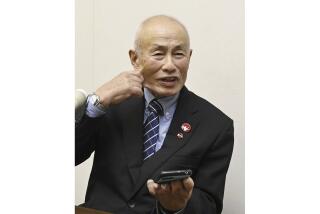Op-Ed: 72 years after the bombing of Nagasaki, there are 15,000 nuclear weapons in the world
Today is the 72nd anniversary of the atomic bombing of Nagasaki. At 11:02 a.m. Aug. 9, 1945, a five-ton plutonium bomb exploded a third of a mile above the city. Its blast winds tore through the city at two and a half times the speed of a Category 5 hurricane.
Two-year-old Masao Tomonaga was asleep in his home while his mother worked in another room. Within seconds of the blast, their house imploded on top of them. Remarkably, both survived. At 1.7 miles from the bomb’s hypocenter, they were out of reach of its most intense infrared heat rays, which instantly carbonized human and animal flesh and vaporized the internal organs of those directly beneath the bomb.
Tomonaga’s mother pushed her way through the rubble to find him. They had minutes to escape to a hillside shrine before fires sped through their neighborhood, leaving their flattened home in ashes.
Six weeks ago, 74-year-old Tomonaga, now a leading specialist on long-term radiation effects on the human body, flew to New York as Nagasaki’s official representative in support of a breakthrough international nuclear weapons ban treaty, adopted at the United Nations on July 7.
Whether by intentional military choice ... or an act of terrorism, we risk far worse humanitarian and environmental disasters than Nagasaki and Hiroshima.
Backed by 122 nations and with strong support from civil society organizations across the globe, the accord is the world’s first comprehensive treaty banning the use, threat of use and production of nuclear weapons. It places nuclear weapons on the same legal footing as all other weapons of mass destruction — including chemical and biological weapons, landmines and cluster munitions, which have long been outlawed.
The treaty was not an act of naiveté. Its proponents knew that nuclear-armed and nuclear-defended nations — including Japan — would vehemently reject the ban, defending their position that nuclear weapons prevent nuclear war. The ban was negotiated too with clear understandings of the current heightened tensions between the United States and Russia, because of North Korea’s nuclear weapons development and testing, and President Trump’s nuclear posturing.
The strategy — as was successfully implemented with landmines — is to delegitimize and ultimately eliminate the most destructive and inhumane weapons made. After treaty ratification in September, the next step is to convince first one, then other nuclear-armed or defended nations to abide by it. Similar treaties banning weapons of mass destruction have resulted in policy changes even by countries that haven’t signed them — including the United States, which now follows the landmines ban without having signed that treaty.
Testimony like Tomonaga’s can only help. Using his experience as a survivor, radiation scientist and physician who has treated hibakusha (atomic bomb-affected people) for nearly 50 years, Tomonaga gave a statement before the United Nations that countered vague images of nuclear war with details of its terrifying acute and long-term human consequences.
Within weeks of the Hiroshima and Nagasaki bombings, adults and children began experiencing mysterious and excruciating symptoms: vomiting, fever, dizziness, bleeding gums and hair loss. Purple spots began appearing all over their bodies — the effects of high-dose, whole-body radiation exposure. Many died within a week of the first symptoms.
Over the next nine months, pregnant women whose fetuses had been exposed in utero suffered spontaneous abortions, stillbirths and infant deaths. Many newborns developed physical and mental disabilities.
By 1948, childhood and adult leukemia rates began increasing among hibakusha — and these rates remained high for decades. At highest risk were children under 10 within a mile of the bombing, who developed leukemia at a rate 18 times greater than the general population.
By 1955, numerous other cancers also appeared at rates far higher than for non-hibakusha. Even today, the bomb’s radiation continues to ravage the bodies of aging survivors, now in their 70s and 80s, who are developing a special type of leukemia, MDS (Myelodysplastic syndrome). Scientists are still studying second- and third-generation hibakusha for genetic effects potentially passed down from their parents and grandparents, reminding us how much we still don’t understand about the insidious nature of radiation exposure on the human body.
The use of a nuclear weapon, designed to inflict catastrophic harm to vast numbers of people, would violate international law, which prohibits the targeting of civilians during wartime. Yet almost 15,000 nuclear weapons still exist in the world today; more than 4,000 are actively deployed across the globe. Whether by intentional military choice, a nuclear accident or an act of terrorism, we risk far worse humanitarian and environmental disasters than Nagasaki and Hiroshima.
After decades of monumental efforts to champion Tomonaga’s vision of a world free of nuclear weapons, this treaty fills the legal gap in the prohibition of such weapons and puts us on the path to their total elimination. Perhaps now there is a chance that after a 72-year reign of nuclear terror, the narrative of nuclear war that started in 1945 will come to a close.
Susan Southard is the author of “Nagasaki: Life After Nuclear War,” which was the recipient of the Lukas Book Prize and the Dayton Literary Peace Prize.
Follow the Opinion section on Twitter @latimesopinion or Facebook
More from Opinion:
Does state funding for Medi-Cal discriminate against the Latinos it serves?
More to Read
A cure for the common opinion
Get thought-provoking perspectives with our weekly newsletter.
You may occasionally receive promotional content from the Los Angeles Times.










